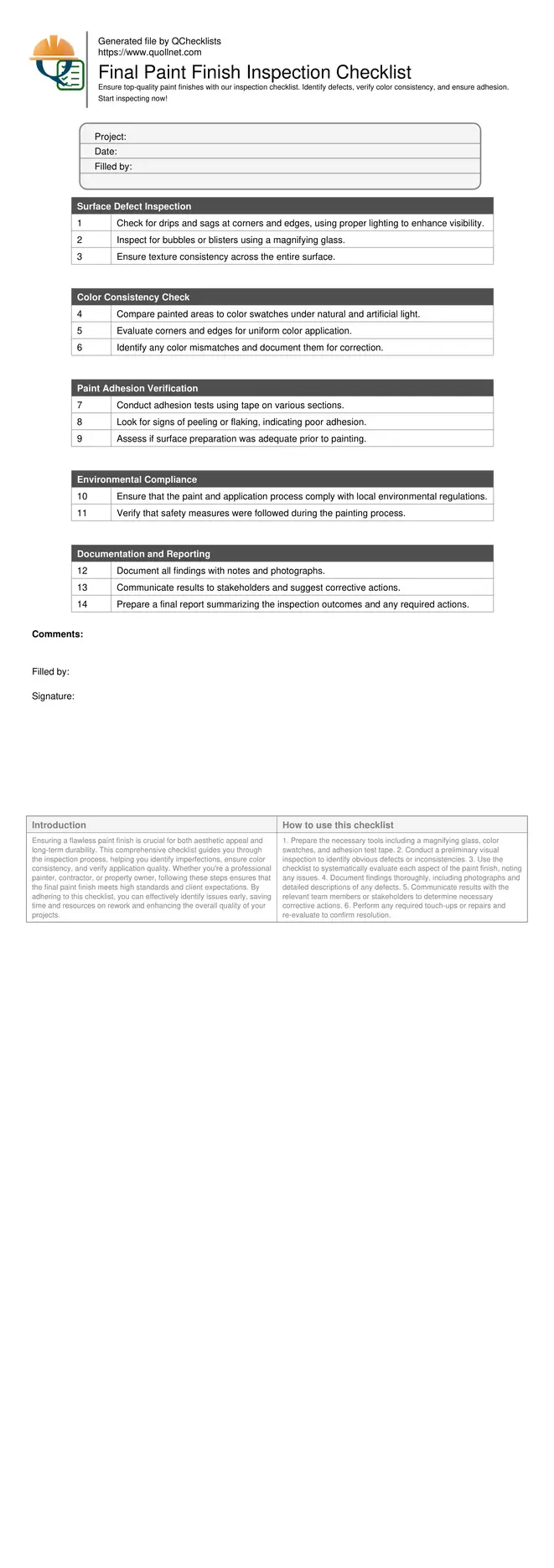Comprehensive Guide to Inspecting Final Paint Finishes
Ensuring a flawless paint finish is crucial for both aesthetic appeal and long-term durability. This comprehensive checklist guides you through the inspection process, helping you identify imperfections, ensure color consistency, and verify application quality. Whether you're a professional painter, contractor, or property owner, following these steps ensures that the final paint finish meets high standards and client expectations. By adhering to this checklist, you can effectively identify issues early, saving time and resources on rework and enhancing the overall quality of your projects.
- Ensure surface perfection by identifying common defects like drips, sags, and uneven textures.
- Verify color consistency across entire surfaces to maintain visual harmony and client satisfaction.
- Assess paint adhesion and uniformity to prevent peeling and ensure longevity.
- Check environmental compliance and safety standards for a responsible and safe painting process.
- Document inspection findings meticulously to facilitate effective communication and resolution.
Surface Defect Inspection
Color Consistency Check
Paint Adhesion Verification
Environmental Compliance
Documentation and Reporting
Identifying Paint Defects
Inspecting a final paint finish involves recognizing and addressing common defects that can detract from the surface's appearance and durability. Spotting issues such as drips, sags, bubbles, and uneven textures is essential. Using proper lighting and viewing angles enhances defect visibility, allowing for precise rectifications. Inspectors should use a magnifying glass for close-up examination of potential problem areas.
- Look for drips and sags at corners and edges.
- Check for bubbles or blisters on the surface.
- Ensure the texture is even and consistent.
- Use natural and artificial lighting for thorough inspection.
- Employ a magnifying glass for detailed examination.
Ensuring Color Consistency
Color consistency is paramount in achieving a uniform look across surfaces. Inspectors should compare different sections under varying light conditions to identify any discrepancies. It's important to reference color swatches or samples for accuracy. Inconsistencies may arise from improper mixing or application techniques, requiring corrective measures.
- Compare painted areas under natural and artificial light.
- Use color swatches for accurate comparison.
- Check for uniformity in corners and edges.
- Identify areas with potential color mismatches.
- Ensure correct paint mixing and application techniques.
Evaluating Paint Adhesion
Proper adhesion is crucial for the longevity of a paint finish. Inspectors should verify that the paint adheres well to the substrate by conducting adhesion tests. Check for peeling or flaking, which could indicate underlying issues such as surface contamination or inadequate surface preparation. These evaluations help ensure the paint finish will endure environmental stresses.
- Conduct adhesion tests using tape or other methods.
- Look for signs of peeling or flaking.
- Assess surface preparation prior to painting.
- Identify potential contamination sources.
- Ensure paint compatibility with substrate materials.
How to Use the Final Paint Finish Inspection Checklist
- Prepare the necessary tools including a magnifying glass, color swatches, and adhesion test tape.
- Conduct a preliminary visual inspection to identify obvious defects or inconsistencies.
- Use the checklist to systematically evaluate each aspect of the paint finish, noting any issues.
- Document findings thoroughly, including photographs and detailed descriptions of any defects.
- Communicate results with the relevant team members or stakeholders to determine necessary corrective actions.
- Perform any required touch-ups or repairs and re-evaluate to confirm resolution.
Call to Action
- Start Checklist Tick off tasks, leave comments on items or the whole form, and export your completed report to PDF or Excel—with a built-in QR code for authenticity.
- Download Excel - Final Paint Finish Inspection Checklist
- Download PDF - Final Paint Finish Inspection Checklist
- View Image - Final Paint Finish Inspection Checklist
